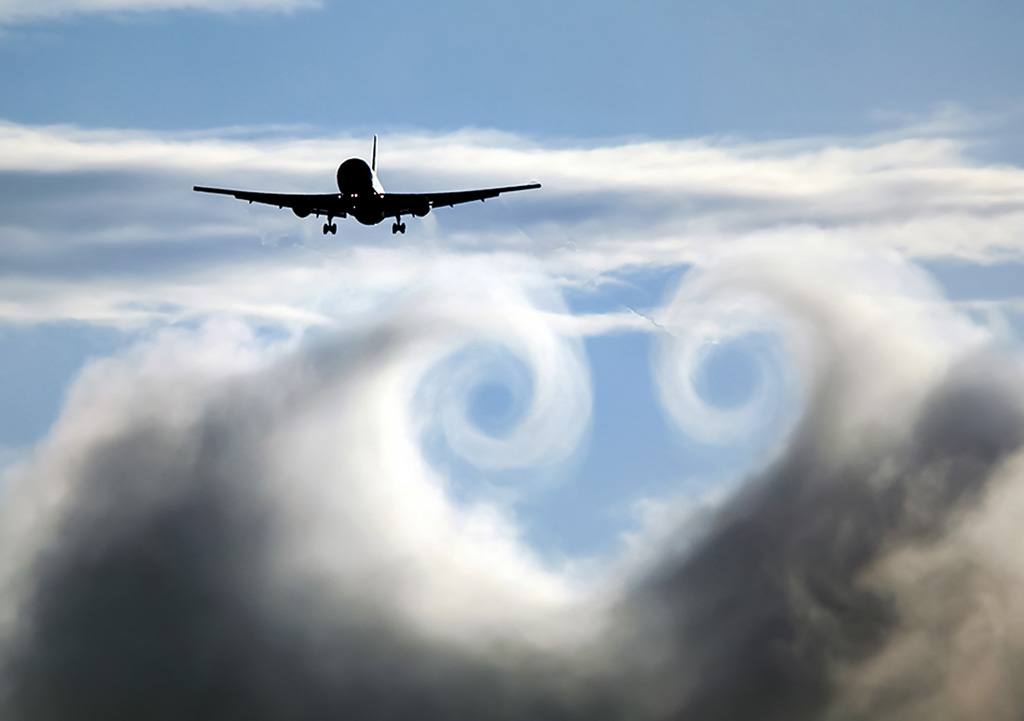RELATED CAPABILITIES:
Wake Turbulence Encounters (A35_A11L.UAS.75)
The Federal Aviation Administration (FAA) has determined that there is a need to identify the analysis and testing requirements to assess: the severity of inadvertent Unmanned Aircraft System (UAS) wake vortex encounters (WVE) and the severity of wing flutter for a fixed wing UAS. These studies, along with associated safety analyses, are needed to support policy, guidance, and procedures to mitigate the risk of UAS upset due to wake encounter and flutter.
The approach taken to address WVEs is to use simulation of wake encounters for a range of UAS, and to validate simulation via flight test. The simulation and flight test procedures thus developed are general in nature and can be used to extrapolate to a wider range of UAS.
The overall benefit of this research is to support safe integration of UAS into the National Airspace System (NAS) by assisting the FAA assess risks of UAS upsets due to wake vortex encounters and flutter events. As such the results of simulation and testing are aimed at providing methods to support rule-making by the FAA.
The sponsor has provided a number of research questions which have been considered and which form the overall guidance for the studies reported here. These are:
- What are the important parameters when assessing UAS response to wake vortex encounters?
- What is the severity of UAS upset due to wake vortex encounters?
- What mitigations might be considered to decrease the severity of UAS upset?
- What degree of flight testing is required to validate wake encounter assessments?
- What are the important parameters when assessing the potential for flutter for fixed-wing UAS?
- What degree of flight testing is required to validate flutter potential assessments?
The key findings are:
- Wake vortices from large aircraft pose a significant risk of upset to small UAS over long distances, up to multiple miles, below the path of the wake-generating aircraft, including directly below and laterally in the presence of a cross-wind.
- The severity of an adverse UAS wake vortex encounter includes the possibility of either loss of control or structural failure—possibly leading to impact with the ground.
- When the ratio of wake-induced velocities to UAS cruise velocity is high, linear aerodynamic models used for response simulation fail to faithfully predict UAS response.
- The severity of adverse UAS wake vortex encounters can be reduced to the severity of encounters with ambient meteorological conditions by physical segregation from volumes of airspace below and along-side known, large aircraft flight paths.
- The severity of adverse UAS wake encounter might be able to be reduced by employing an autopilot with the ability to recover from an entry into loss of control, especially if the UAS has the ability to sense the entry into loss of control, and especially if significant excess thrust is available to “power through” entry into loss of control.
- The potential of the ability to predict the approach to the loss of control (e.g., using the aircraft’s state and control input correlations) and to adopt mitigating guidance commands (e.g., increasing cruise velocity) may prove to be useful for autonomously avoiding unrecoverable loss of control.
- Reducing for the expected uncertainties in engineering level dynamic models through system identification flight testing is essential to reliably predict the response of UASs during wake vortex encounters.
- Flights through air velocity fields representative of wake vortices provide one method of determining the susceptibility of a UAS to upset; to be most useful:
- the velocity of the air through which the UAS fly must be known in some way.
- the degree of upset seen in flight test must be predicted in simulation.
- Flights through actual large aircraft vortices are the best type of flight test to assess UAS response to a WVE.
- The stiffness and mass distribution of a UAS wing must be known and verified by ground vibration testing to assess flutter risk.
- Flight testing of a wing is essential if it has a predicted, air-density-adjusted flutter speed approaching the maximum expected dive speed.
Key Conclusions:
The comparisons between physics-based simulations and actual flight test validations highlight the shortcomings of UAS Linear Time-Invariant (LTI) dynamic models in predicting small Unmanned Aircraft System (sUAS) response to a wake vortex encounter. Although nonlinear 6 Degree of Freedom (6DOF) simulations retain some degree of nonlinear effects (i.e. the coupling of longitudinal and lateral states), they cannot capture the accurate response of hazardous wake encounters because of the use of linear aerodynamic models. These issues are rooted in the unsteady and nonlinear nature of aerodynamic forces and moments during UAS wake encounters. Complex time and angular rate-dependent couplings between dynamic states cannot be captured by simplified, engineering-level linear dynamic models. This is why the aerodynamic forces predicted in the simulations deviate significantly from actual validation flight tests.
The research team recommends the following for potential follow-on work:
- Flight testing of a range of small UAS through actual wake vortices with:
- Some method of identifying where the wakes are, for instance, using ADS-B transmissions from the generating aircraft to provide guidance as well as adequate separation.
- Some method of measuring the air velocity through which it flies.
- Simulations which predict the response.
- Further development of a process to mitigate the risk of UAS loss of control in a wake vortex encounter by physical separation distances.
- To enhance the simulation capabilities to capture the extreme response:
- Continue development of the non-linear force, moment and propulsion algorithms pioneered in the current research.
- Continue flights through air velocity fields generated by wind machines, including larger wind fields.
FINAL REPORT | 
POC:
Mark Ewing
Associate Professor
Director of the Flight Research Laboratory
University of Kansas
Email: mewing@ku.edu
Phone: 785.864.2964



